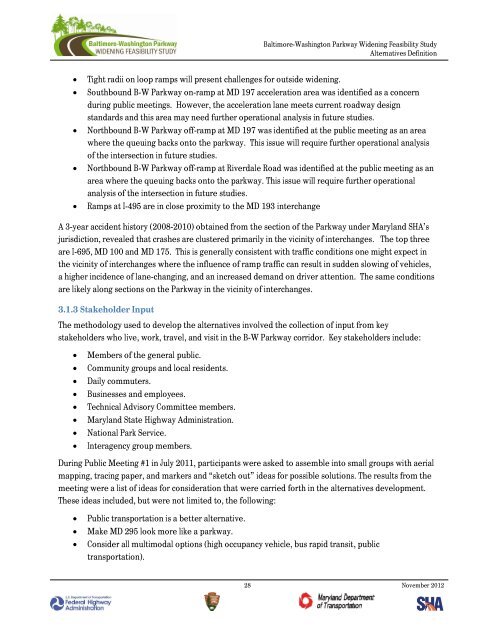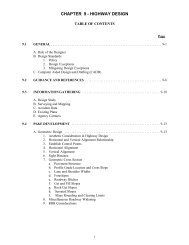Baltimore-Washington Parkway Widening Feasibility Study
Baltimore-Washington Parkway Widening Feasibility Study
Baltimore-Washington Parkway Widening Feasibility Study
- No tags were found...
You also want an ePaper? Increase the reach of your titles
YUMPU automatically turns print PDFs into web optimized ePapers that Google loves.
<strong>Baltimore</strong>-<strong>Washington</strong> <strong>Parkway</strong> <strong>Widening</strong> <strong>Feasibility</strong> <strong>Study</strong>Alternatives DefinitionTight radii on loop ramps will present challenges for outside widening.Southbound B-W <strong>Parkway</strong> on-ramp at MD 197 acceleration area was identified as a concernduring public meetings. However, the acceleration lane meets current roadway designstandards and this area may need further operational analysis in future studies.Northbound B-W <strong>Parkway</strong> off-ramp at MD 197 was identified at the public meeting as an areawhere the queuing backs onto the parkway. This issue will require further operational analysisof the intersection in future studies.Northbound B-W <strong>Parkway</strong> off-ramp at Riverdale Road was identified at the public meeting as anarea where the queuing backs onto the parkway. This issue will require further operationalanalysis of the intersection in future studies.Ramps at I-495 are in close proximity to the MD 193 interchangeA 3-year accident history (2008-2010) obtained from the section of the <strong>Parkway</strong> under Maryland SHA’sjurisdiction, revealed that crashes are clustered primarily in the vicinity of interchanges. The top threeare I-695, MD 100 and MD 175. This is generally consistent with traffic conditions one might expect inthe vicinity of interchanges where the influence of ramp traffic can result in sudden slowing of vehicles,a higher incidence of lane-changing, and an increased demand on driver attention. The same conditionsare likely along sections on the <strong>Parkway</strong> in the vicinity of interchanges.3.1.3StakeholderInputThe methodology used to develop the alternatives involved the collection of input from keystakeholders who live, work, travel, and visit in the B-W <strong>Parkway</strong> corridor. Key stakeholders include:Members of the general public.Community groups and local residents.Daily commuters.Businesses and employees.Technical Advisory Committee members.Maryland State Highway Administration.National Park Service.Interagency group members.During Public Meeting #1 in July 2011, participants were asked to assemble into small groups with aerialmapping, tracing paper, and markers and “sketch out” ideas for possible solutions. The results from themeeting were a list of ideas for consideration that were carried forth in the alternatives development.These ideas included, but were not limited to, the following:Public transportation is a better alternative.Make MD 295 look more like a parkway.Consider all multimodal options (high occupancy vehicle, bus rapid transit, publictransportation).28 November 2012
















